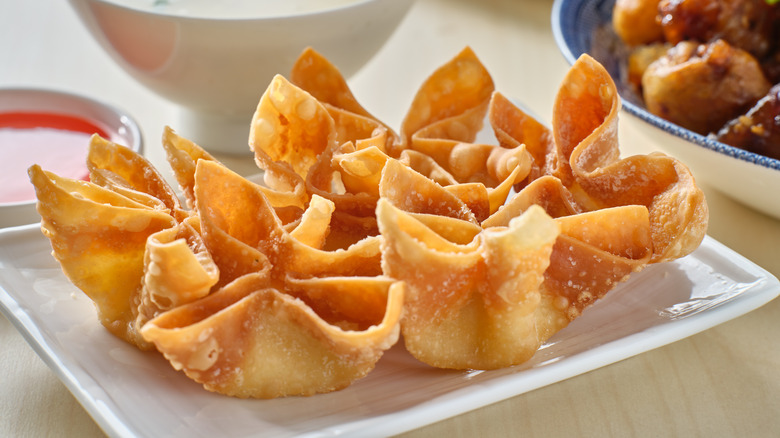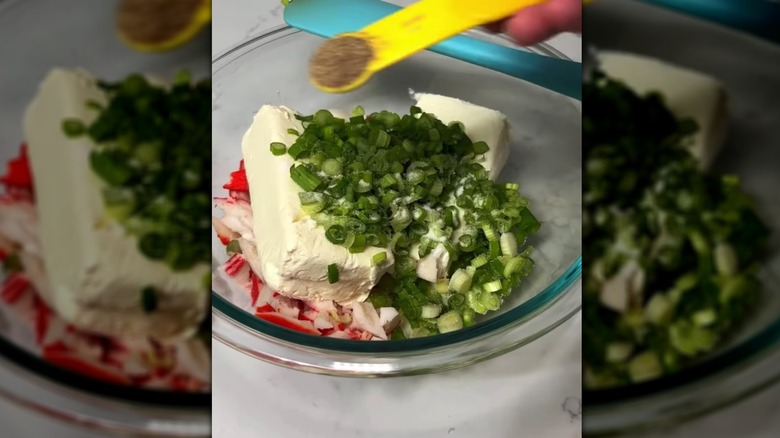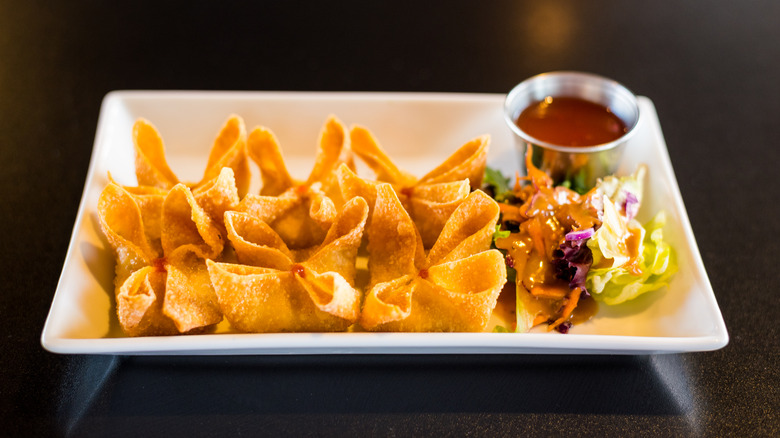The Simple Method You Can Use To Upgrade Your Crab Rangoon
When it comes to unexpected recipes, the TikTok to Instagram to home kitchen pipeline seems to grow ever more recurrent. There are likely thousands of madcap food experiments that never make it beyond the walls of the metaverse, but the ones that do tend to rack up millions of views and nearly as many testimonials from home cooks and celebrity chefs alike.
Baked tomato feta pasta, whipped Dalgona coffee, and four-topping tortilla wraps have shared the stage with more questionable concoctions such as watermelon and yellow mustard, pickles and Kool-aid, and Flamin' Hot Cheetos and ranch dressing mix. In 2021, TikTok even went so far as to launch a national network of virtual kitchens, per Bloomberg.
Many TikTok recipes are novel inventions, but others are spins on retro dining trends. Crab rangoon, a mainstay appetizer on Chinese American takeout menus, is a perfect example. As of this writing, the hashtag #crabrangoon has more than 400 million views on the app. We can't say what caused this sudden surge in fanfare for the dish on social media, but we're not complaining. If you're trying to perfect your own crab rangoon at home, here's a simple tip to level up the end result.
Bring your cream cheese to room temp
Not every crab rangoon is alike, but they all share the same basic components of crispy-crunchy fried or baked wontons piped with creamy crab filling. Food blogger Julie Tran Deily of The Little Kitchen took to Instagram to share her recipe, which she first published in 2009. She even cites the dish as the initial inspiration behind her food blog.
For Deily, the trick to a perfect batch of crab rangoon isn't a secret ingredient, but rather, a preparation step. She suggests bringing your cream cheese — the binding agent of the simple filling — to room temperature. "The texture of the filling will be so creamy and so irresistible if you do that," she says in her Instagram Reel.
Letting your cream cheese shed its chill will allow it to mix more easily with its fellow ingredients, which in Deily's recipe include imitation crab meat, scallions, and salt and pepper. The smooth texture will also make it easier to wrap the wontons before frying, which Deily says should resemble "little ghosts." Don't forget the sweet and sour dipping sauce.
A Chinese-American invention
Crab rangoon is to China what chicken parmesan is to Italy. Both were invented by immigrants living in America, but you probably won't find them served in the countries to which they're linked. Like kung pao chicken, orange chicken, and beef and broccoli, crab rangoon is wound up in the long and complex history of Chinese-American cuisine. According to Atlas Obscura, opening a restaurant was "one of the few ways for a Chinese American to own a business" in the early 1900s, back when anti-Asian exclusionary laws made it extremely difficult for Chinese immigrants to live in the United States.
The outlet writes that Chinese restaurants nearly quadrupled between 1910 and 1920, making Chinese food the first Asian cuisine to capture the attention of Americans. But many such Americans weren't keen on introducing traditional Chinese flavors to their repressed palates. On top of that, ingredients such as Szechuan peppercorns were a lot harder to find in the U.S. than in China. Enter: "Americanized" versions of Chinese dishes, including crab rangoon.
The New England newspaper Sampan cites a popular theory that crab rangoon finds its roots in the onset of tiki culture capitalized upon by Trader Vic's founder Victor Bergeron. When tiki bars and Chinese restaurants were sharing the popularity stage in the 1940s and '50s, they also shared some menu items. Urban legend has it that crab rangoon was one of them, which explains the slight differences between the dish's Polynesian American and Chinese American versions.


